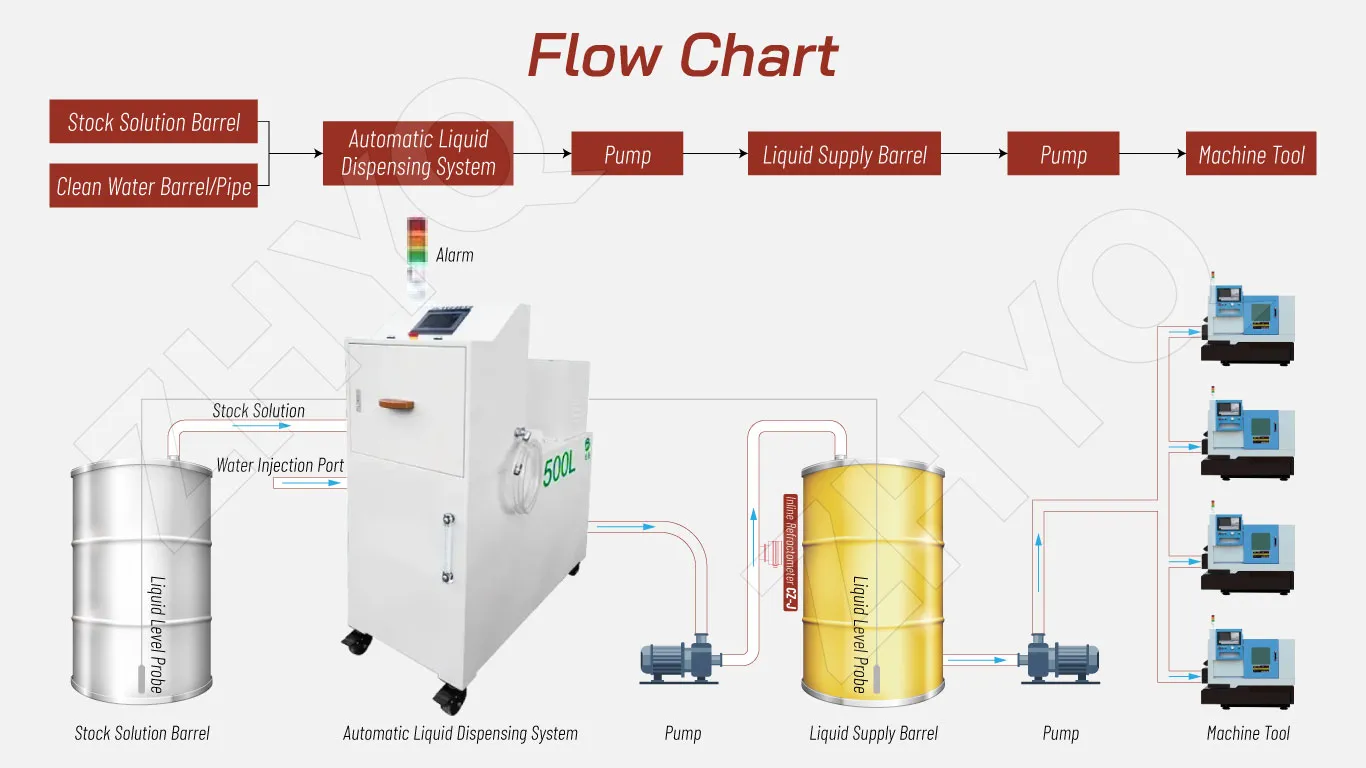Machining centers, CNC machine tools and integrated machine tools are the core equipment of precision manufacturing. They undertake the task of processing high-precision parts in industries such as mechanical processing, automobile manufacturing, and aerospace. In the processing process, cutting fluid is an indispensable key auxiliary material. It directly affects the processing accuracy, tool life and production efficiency through cooling, lubrication, chip removal and rust prevention.
the concentration of the cutting fluid used in the machining process is too high, it will not only cause a great waste, but may also lead to certain adverse consequences; if the concentration is too low, it may cause the metal material to rust or corrode, increase tool wear, and affect the quality of metal processing ; in order to ensure the stability of the liquid level and avoid dry running of the equipment, higher requirements are placed on the liquid level management of the cutting fluid.
Therefore, the liquid level and concentration of the cutting fluid are important parameters for it to exert its effectiveness, protect equipment, and ensure processing quality .
Traditional cutting fluid management mainly relies on manual operation, which is as follows:
1.In terms of liquid level management, the operator regularly observes the liquid level scale of the machine tool cutting fluid tank and judges whether cutting fluid needs to be added based on experience. Generally, manual liquid replenishment is performed when the liquid level is lower than 1/3 of the tank;
2.In terms of concentration control, a small amount of samples are taken from the cutting fluid tank regularly using a handheld refractometer, and the refractive index is measured to convert the concentration, and then concentrated liquid or water is added to adjust the concentration based on experience, usually maintaining the concentration between 5% and 8%. This method lacks systematic monitoring means and relies entirely on human responsibility and experience, making it difficult to achieve continuous and accurate management.
Manual detection is discrete and cannot capture sudden drops in liquid levels (such as leaks) or real-time fluctuations in concentration during processing.
Visual liquid level is inaccurate; handheld refractometer measurement is greatly affected by the representativeness of the sampling point, sample temperature, operator reading, and calibration status.
In a multi-machine environment, frequent manual inspection and adjustment consumes a lot of man-hours.
The lack of continuous historical data on liquid level and concentration makes it difficult to conduct trend analysis, optimize management and trace the root cause of the problem.
Delayed concentration adjustment causes the processing to be in a non-optimal state for a long time, affecting quality and cost.
If the liquid level is too low and is not discovered in time, it may cause equipment dry-running damage or even safety accidents.
1.Liquid level transmitter :
Type selection: immersion level meter (PT124B-220) or oil-resistant captive type (PT124B-225A). The effects of coolant foam, oil pollution and temperature need to be considered.
Installation: Directly mounted on the top of the liquid supply tank, providing continuous, real-time liquid level percentage or high-precision signal (4-20mA, Modbus, etc.).
2.Inline refractometer :
Type selection: Designed for cutting fluid environments, with automatic temperature compensation (ATC), pollution-resistant, easy-to-clean optical prisms.
Installation: Installed in the main circulation pipeline or water tank through bypass or direct immersion probe, real-time and continuous measurement of the refractive index/Brix value of the coolant, and direct output of concentration percentage signal (4-20mA, Modbus, etc.).

| Disadvantages of traditional technology | Advantages of Intelligent Monitoring Solutions | The core value brought |
| Lag and non-real-time | Continuously and in real time monitor liquid level and concentration to catch abnormalities instantly | Prevent equipment damage due to dry running, avoid fluctuations in processing quality, and improve production continuity. |
| Large human error |
High-precision, objective measurement, reducing reading, sampling, and temperature errors |
Ensure that the coolant status is accurate and reliable, providing a real basis for quality stability and equipment protection. |
| High labor intensity & low efficiency |
Automatic monitoring greatly reduces manual operation time |
Liberate labor, reduce labor costs and improve production efficiency. |
| Data missing & no traceability |
Digital record storage, complete historical data and trend curves |
Achieve process traceability to support root cause analysis, process optimization, and management decision-making |
| Untimely/imprecise adjustments | Optional automatic closed-loop control to achieve precise, real-time adjustment of liquid level and concentration | Maintain the coolant in optimal working condition, maximize its efficiency, stabilize processing quality and reduce waste. |
| Safety hazard (liquid level is too low) | Real-time alarm and automatic shutdown protection (such as linkage equipment) to prevent dry running | Significantly improve equipment safety and avoid major losses |

Shanghai Zhaohui Pressure Apparstus Co.,Ltd. – A comprehensive high-tech enterprise integrating R&D, production, and sales. With products distributed nationwide and exported to over 50 countries and regions, the company achieves annual sales of millions of sensing elements, sensors (transmitters), and control systems.
© 2025 Shanghai Zhaohui Pressure Apparstus Co.,Ltd. All Rights Reserved.
Designed by AdmarV